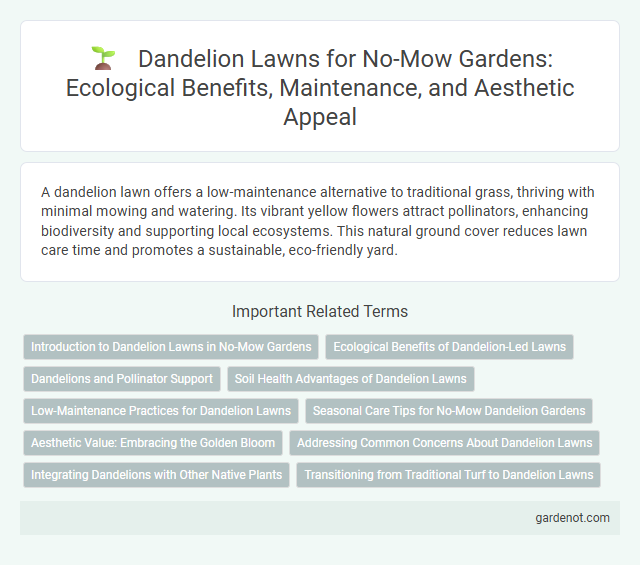A dandelion lawn offers a low-maintenance alternative to traditional grass, thriving with minimal mowing and watering. Its vibrant yellow flowers attract pollinators, enhancing biodiversity and supporting local ecosystems. This natural ground cover reduces lawn care time and promotes a sustainable, eco-friendly yard.
Introduction to Dandelion Lawns in No-Mow Gardens
Dandelion lawns in no-mow gardens provide a resilient, low-maintenance alternative to traditional grass, thriving with minimal care. Their deep root systems improve soil health and prevent erosion, while vibrant yellow flowers support local pollinators like bees and butterflies. This sustainable lawn choice reduces water usage and eliminates the need for mowing, making it ideal for eco-friendly landscaping.
Ecological Benefits of Dandelion-Led Lawns
Dandelion-led lawns enhance soil health by improving aeration and nutrient cycling through their deep taproots, which also promote water infiltration and reduce erosion. Their flowers serve as a vital early spring nectar source for pollinators such as bees and butterflies, supporting local biodiversity. This natural ground cover reduces the need for chemical fertilizers and pesticides, contributing to a more sustainable and eco-friendly lawn ecosystem.
Dandelions and Pollinator Support
Dandelion lawns offer a vibrant habitat that supports pollinators such as bees and butterflies by providing abundant nectar and pollen throughout the growing season. These resilient plants improve soil health through deep taproots that aerate and recycle nutrients, promoting a sustainable ecosystem. Maintaining a dandelion lawn enhances biodiversity and encourages natural pollination, making it an eco-friendly alternative to traditional grass lawns.
Soil Health Advantages of Dandelion Lawns
Dandelion lawns enhance soil health by deeply penetrating roots that break up compacted soil, improving aeration and water infiltration. Their taproots draw essential nutrients like calcium from deeper soil layers closer to the surface, enriching soil fertility naturally. This promotes microbial activity and creates a more balanced, nutrient-rich environment for surrounding plants.
Low-Maintenance Practices for Dandelion Lawns
Dandelion lawns thrive with minimal upkeep, requiring infrequent mowing and occasional watering during dry spells, making them ideal for low-maintenance landscapes. These resilient plants naturally enrich soil with deep taproots that improve aeration and nutrient cycling while resisting pests and diseases. Embracing dandelion lawns reduces the need for fertilizers and herbicides, promoting eco-friendly gardening and conserving water resources.
Seasonal Care Tips for No-Mow Dandelion Gardens
No-mow dandelion gardens require minimal maintenance, thriving with seasonal care that includes mowing once a year in late fall to remove dead foliage and promote healthy regrowth. Applying a balanced, nitrogen-rich fertilizer in early spring supports robust growth and vibrant yellow blooms from late spring to early summer. Regularly checking for invasive weeds and ensuring adequate soil moisture during dry spells helps maintain the garden's health and aesthetic appeal throughout the growing season.
Aesthetic Value: Embracing the Golden Bloom
Dandelion lawns offer a unique aesthetic value with their radiant golden blooms that create a vibrant, natural tapestry across green spaces. The bright yellow flowers not only enhance curb appeal but also attract pollinators like bees and butterflies, supporting local biodiversity. Embracing a no-mow approach allows these blossoms to flourish, transforming traditional lawns into dynamic, eco-friendly gardens rich in seasonal color.
Addressing Common Concerns About Dandelion Lawns
Dandelion lawns naturally reduce the need for mowing due to their low growth habit and hardy nature, making them ideal for no-mow lawn enthusiasts. Concerns about dandelions being invasive are mitigated by their ability to promote soil health and support pollinators like bees and butterflies. Proper maintenance, such as occasional trimming around walkways, ensures that dandelion lawns remain attractive without overtaking other plants.
Integrating Dandelions with Other Native Plants
Integrating dandelions with other native plants creates a resilient, biodiverse no-mow lawn that supports pollinators and improves soil health. Combining dandelions with clover, violets, and wildflowers enhances ecosystem benefits by offering a variety of nectar sources and ground cover. This mixture reduces the need for artificial fertilizers and irrigation while maintaining visual appeal and ecological balance.
Transitioning from Traditional Turf to Dandelion Lawns
Transitioning from traditional turf to dandelion lawns involves allowing dandelions to thrive as a natural ground cover, reducing the need for frequent mowing and chemical treatments. Dandelion lawns enhance biodiversity by providing nectar for pollinators while maintaining a resilient, low-maintenance green space. Embracing dandelion lawns supports sustainable landscaping practices and promotes soil health through deep root systems that improve aeration and nutrient absorption.
Dandelion lawn Infographic

 gardenot.com
gardenot.com